Google Nexus 5 Review
by Brian Klug on December 5, 2013 8:00 AM EST- Posted in
- Smartphones
- LG
- Android
- Mobile
- Snapdragon 800
- Android 4.4
- Nexus 5
Display on mobile devices is one area where we’ve seen considerable improvement. Pixel density has gone up, contrast ratios have improved, and the emphasis on low power in a platform gated by its battery size means there’s always innovation happening.
In the case of the Nexus 5, there’s a considerable jump in resolution, from the WXGA 1280x768 display on the Nexus 4, to the now-standard 1080p. The biggest change is an obvious shift in aspect ratio from 15:9 to 16:9 once more. Back with the Nexus 4 and Optimus G, I noted just how surprisingly noticeable that extra 48 pixels of width was. Although we tend to think in absolute display resolution and talk about it quite a bit, Android uses display independent pixels or dips in order to keep layouts display density agnostic and support a wide variety of screen sizes and resolutions. Nexus 5 implements the 480 ppi or xxhdpi screen density, whereas Nexus 4 implements 320 ppi or xhdpi density. The result is that the Nexus 5’s display is 360x592 dips in size, compared to 384x592 dips for the Nexus 4, coming in 24 dips narrower. It’s important to note however that this change is intentional to maintain Android’s DPI independence, even if it does mean less overall real-estate in apps and browser.
Display quality is a big deal in the Android space, with lots of variance between devices. In the case of the Nexus 5, I started by tracking down the display type. If you recall, 5-inches with 1080p is a resolution we’ve seen before in the Droid DNA and Butterfly. From what I can tell, the Nexus 5 uses a very similar evolved version of that panel, a JDI (Japan Display, Inc) 1080p display with in-cell touch courtesy Synaptics ClearPad 3350 solution.
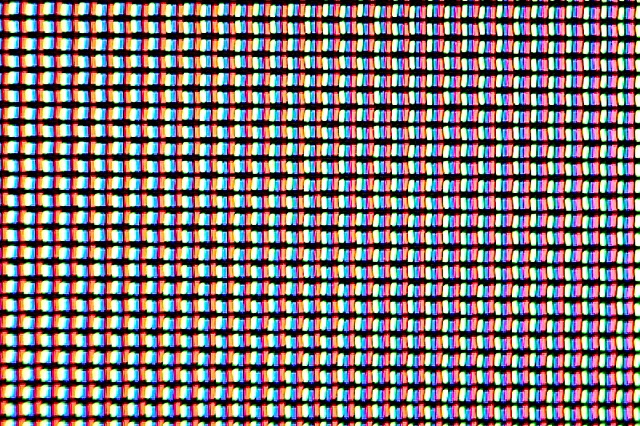
The other question was whether Nexus 5 also uses a PSR (Panel Self Refresh) type display. This display is indeed a MIPI command mode panel, the same kind of system, so yes it does include those features. An additional change is the addition of software vsync in Android 4.4, which to my knowledge the Nexus 5 does use, you can see this pop on and off depending on what’s happening on-screen if you monitor surfaceflinger. Those improvements should decrease latency and improve how sticky animations feel.
To characterize display quality and accuracy, we turn to our usual display measurements.
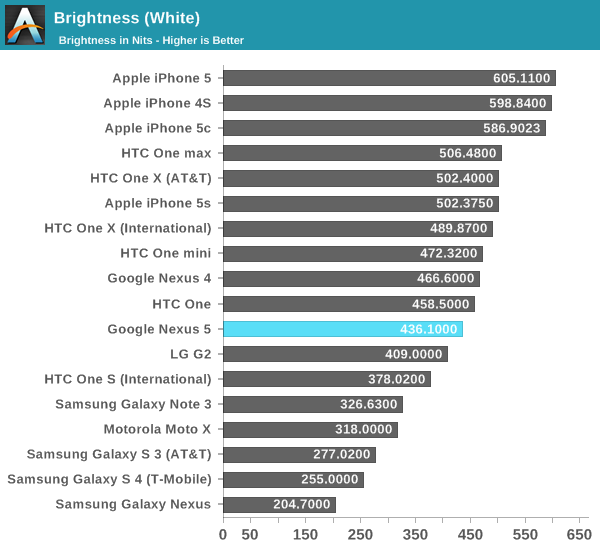
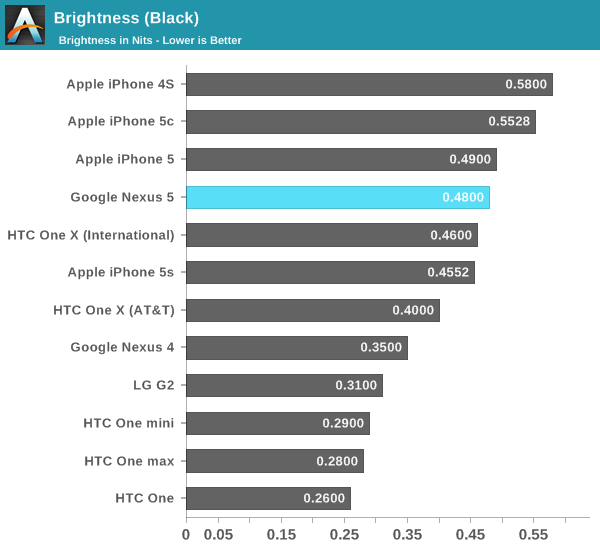
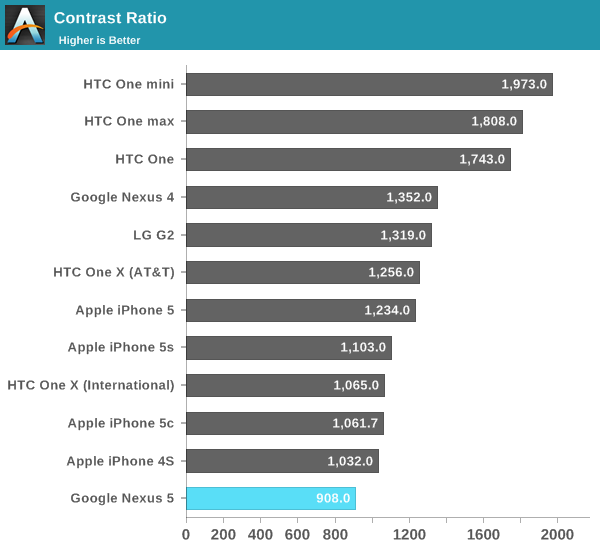
The Nexus 5 doesn’t go quite as bright as Nexus 4, but it’s still a very bright display. Blacks and contrast are a bit disappointing though, contrast is definitely on the lower end, but not bad. I definitely haven’t been put off by them. I also haven’t noticed any of the distracting dynamic brightness behavior I have on other handsets, which is awesome.
My only criticism is that I wish Nexus 5 would allow its auto screen brightness algorithm to go dimmer when in dark scenarios. There’s still more dynamic range in the manual brightness setting bar than there is for the auto brightness routine from what I can tell.

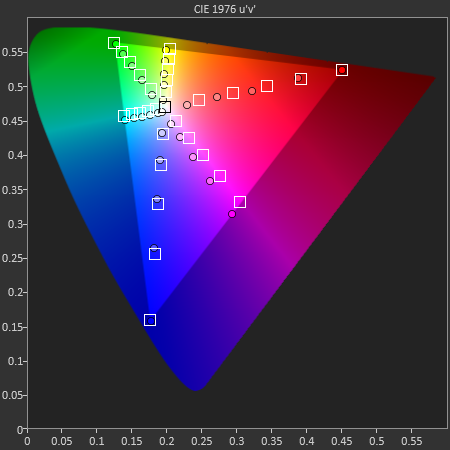
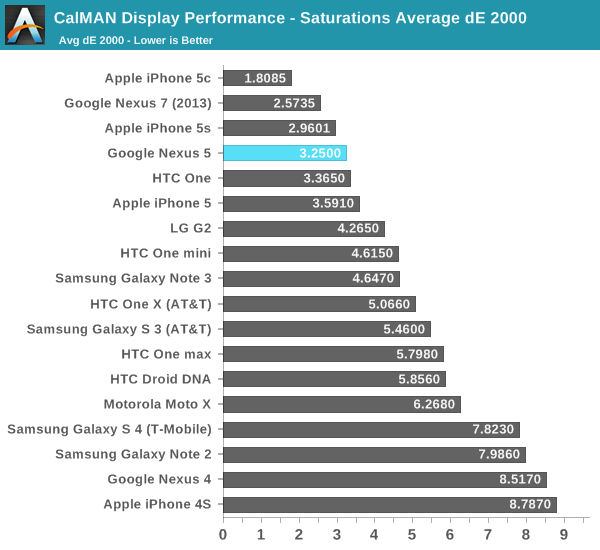
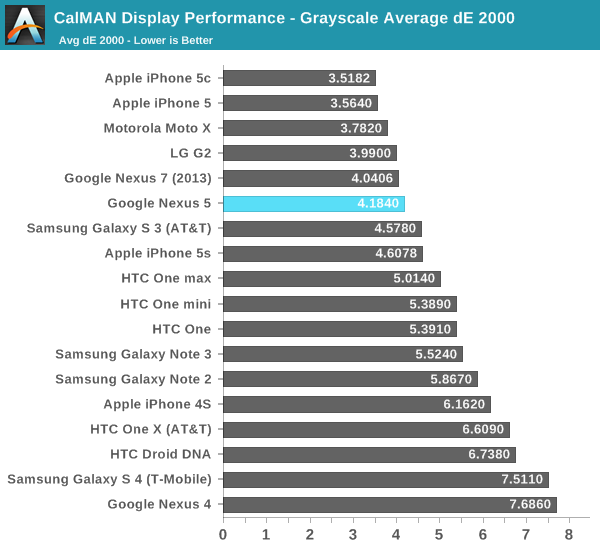
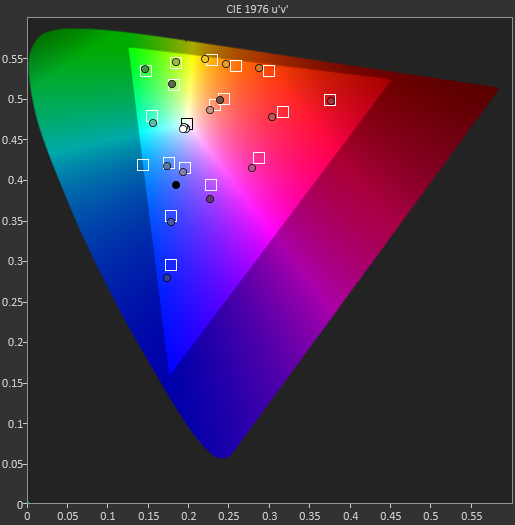
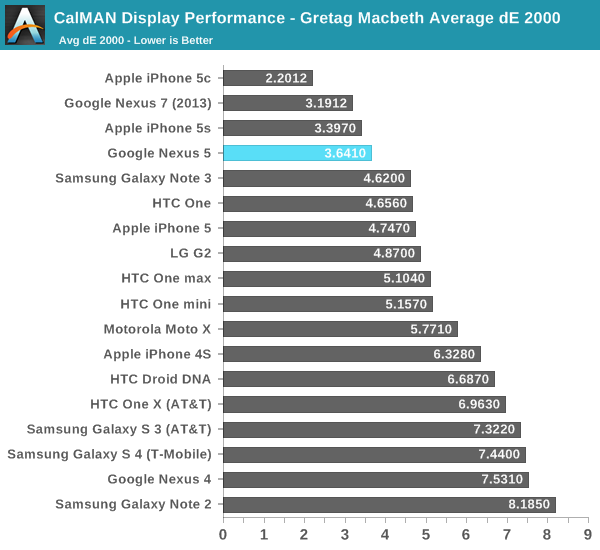
The new Nexus 7 impressed me with how accurate its display was in terms of color reproduction, beginning with Google stating it targeted sRGB (the color space for both the web and Android) calibration for it. The Nexus 5 seems to have done the same, and wowed me with the best GMB color checker Delta-Es we’ve seen from any Android handset. In addition, the Nexus 5 has none of the saturation boost that’s sadly quite pervasive right now, instead giving the right evenly spaced saturation stepping on its color channels. The Nexus 7 has slightly lower Delta-E, but it’s clear to me that Google has made color calibration an emphasis on the Nexus line.
It’s interesting to hear some Nexus 5 users complain that the display seems undersaturated, since that kind of end user feedback reflects subjective comparison. It also suggests to me that a large percentage of the population doesn’t know what some colors or system elements actually should be. Even for me, looking at the green elements inside the Google Play store on the Note 3 in movie mode or Nexus 5 initially seemed slightly more muted than normal. The reality is that this is what they actually should look like. We’ve just become accustomed to their oversaturated appearance on virtually every other device.
This kind of expectation about what looks right and what doesn’t is rather telling for the state of display calibration in Android handsets, and how OEMs have used oversaturated colors to increase retail shelf appeal. Unfortunately the reality is that oversaturated colors do seem to win taste tests among shoppers, the same way that TVs in most big boxes do. We’ve been looking at them for so long that well calibrated displays like Nexus 5 initially do look noticeably different.
The end result is easy to sum up, however – Nexus 5 has the best calibrated display I’ve seen so far in any Android handset. It’s also leaps and bounds more accurate and controlled than its predecessor display in the Nexus 4.


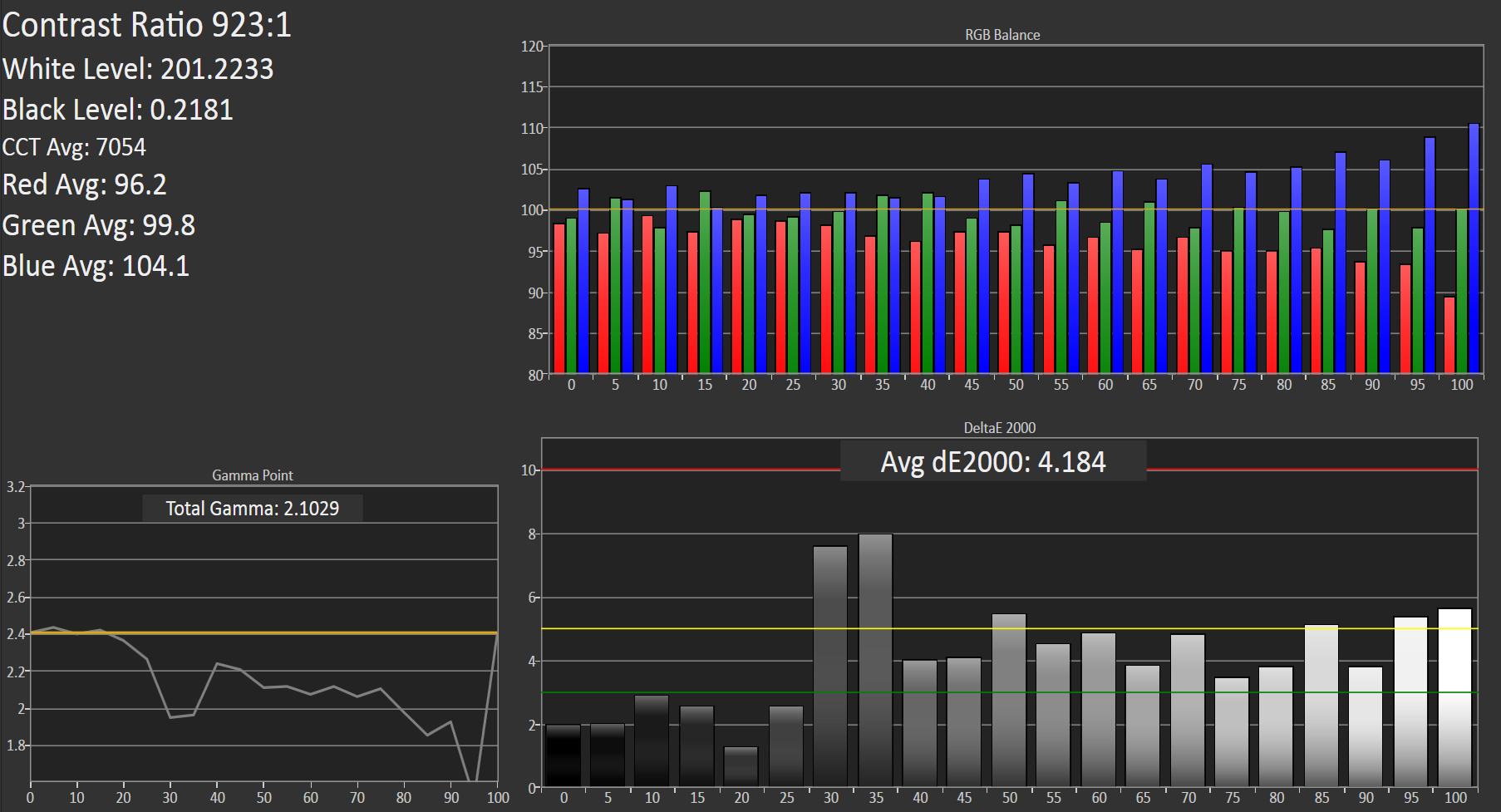








231 Comments
View All Comments
BearCatCow - Thursday, December 5, 2013 - link
What a great article! Very objective and evidence based. The attention to display accuracy rather than whoever pumped up the saturation the most, the clear analysis of the camera's hardware (potential) vs software (current usability), and the multitude of battery measures are very helpful.bioyuki - Thursday, December 5, 2013 - link
Brian: Did you notice any differences in real world rf performance between the Nexus 5 and Nexus 4? Only a few data points on my end, but it seems like the N5 performs on average 3-5 dBm worse than the N4 (LTE and HSPA on Band 4). Also, does the N5 contain any of Qualcomm's tunable front end parts?BearCatCow - Thursday, December 5, 2013 - link
Question: what were the differences in battery performance with ART runtime vs the default?nostriluu - Thursday, December 5, 2013 - link
how about a battery test that's really useful for most people, how a device lasts over the course of a day with a typical set of apps? these rundown tests are really not that helpful.NeoteriX - Thursday, December 5, 2013 - link
What do you specifically propose for an objective, repeatable, platform agnostic test, hmm? What is a typical set of apps? What about the fact that apps are always changing? What about the fact that many apps are not multi-platform or aren't standardized across platforms?The rundown test (based on something agnostic and universal like web page loading) is probably the best kind of objective test you're going to get; you'll just have to extrapolate your daily performance from that.
Besides, as a pragmatic matter, Brian's/Anandtech's reviews are already take so much time and effort to do, and that's with multiple a 5-9 hour long battery tests (LTE, 3G, Wifi...). One can't test any other feature of the phone while battery testing... you want to seriously add a suite of 12-24 hour tests on top of that?
Impulses - Friday, December 6, 2013 - link
Can't believe someone's actually pinning for less controlled/repeatable battery testing just because it might be closer to their own use... AT does the best battery tests bar none, whether they mimic your use or not is irrelevant, just find a phone you own or have owned on their list and extrapolate from there. It'll be far more accurate than a pseudo real world test with too many random variables to account for.flyingpants1 - Saturday, December 7, 2013 - link
Jesus Christ, I cannot believe some of the comments on here. The battery life tests here and everywhere else are terrible. None of them reflect real-world usage whatsoever.The only real test here is a synthetic web-browsing battery life test, and it gives results between 6-10 hours, I'll eat my monitor if anyone's phone actually lasts that long in real-life web-browsing. Obviously a synthetic benchmark can be a useful as a comparative tool between phones, but not much else. It's basically the equivalent of a 3dmark score.
It's a well-known fact.. actually, by now a universally foregone conclusion that smartphones die extremely quickly, and are super annoying to charge. Brian uses phrases like "It can last the whole day on a single charge" which are utterly meaningless. That just means you left your phone in your pocket most of the time. But when you actually want to use your phone in a pinch, or while travelling, or in an emergency, or for serious work, then it's a completely different story. Yet for some reason you wouldn't get that impression from most reviewers. And so we're forced to compromise.
Compare with laptops from a couple years ago, they'd advertise 5 hours of life, get 3 in reality in ideal conditions, and within a year be down to 2 hours. I'm sure a lot of people were happy with that. So what. The Macbook Air came along and gives you up to 12-16 hours. Now *THAT* is all day life. That is what we should be getting on smartphones. 12-16 hours of screen time and constant use. Then we won't need to go and do forty million battery life tests anymore, because the problem is *solved* for 99.9% of use cases. Instead we're getting price gouged like crazy for storage, and R&D goes to things like 500PPI displays and downloading at 150mbps, things which should be of slightly lower importance than making the phone stay alive.
No idle test. This is really important, the percentage drop should be less than 1-2% every 24 hours.
No video test.
No gaming test.
Nobody seems to care about texting. People usually send *way* more texts than they make calls, and texting drains battery faster than calls do. I often run out of battery life on the train while texting, seems like a percentage point every minute or two even with my display on 0%.
The reviewers are definitely on the manufacturer's side on every single issue here: against microSD, against removable batteries, but *FOR* pointlessly thin, even to the point of sacrificing battery life and functionality. If they were on the *consumer's* side, they'd be tearing apart every single 16GB device, advocating the $1 microSD slot for *EVERY PHONE*, and demanding *EVERY PHONE* have either a version with a removable battery, and/or EXTENDED (MAXX) battery version.
My ideal device would be a 5" screen, LG G2 or RAZR MAXX-like device, 10.5mm thick, 4500mah, with 64GB microSD and front speakers like the HTC One. The closest thing right now is the HTC Butterfly S, IMO the best phone on the market by far, there are no tradeoffs at all.
bountygiver - Thursday, December 5, 2013 - link
Well the camera UI didn't go miserable in 4.4, but since 4.3. Navigating settings in 4.3+ camera UI is a pain as toggles have no feedback and there's no tell whether an option is a menu or a toggle.For the not focus problem, just tap another place and tap the original position again to refresh it.
Krysto - Thursday, December 5, 2013 - link
I'm curious why you're calling 512 MB phones "mid-range", when you can find such a phone even for $100 unlocked these days. Even Moto G at $180 is a low-end to mid-range phone, and it has 1 GB of RAM. Is it because you don't want the iPhone to be considered mid-range?Pr3ch34r - Thursday, December 5, 2013 - link
Tell me how would you consider the 5s (or even the 5c) midrange, because of ram and screen size? Both are top of the line, like it or not...